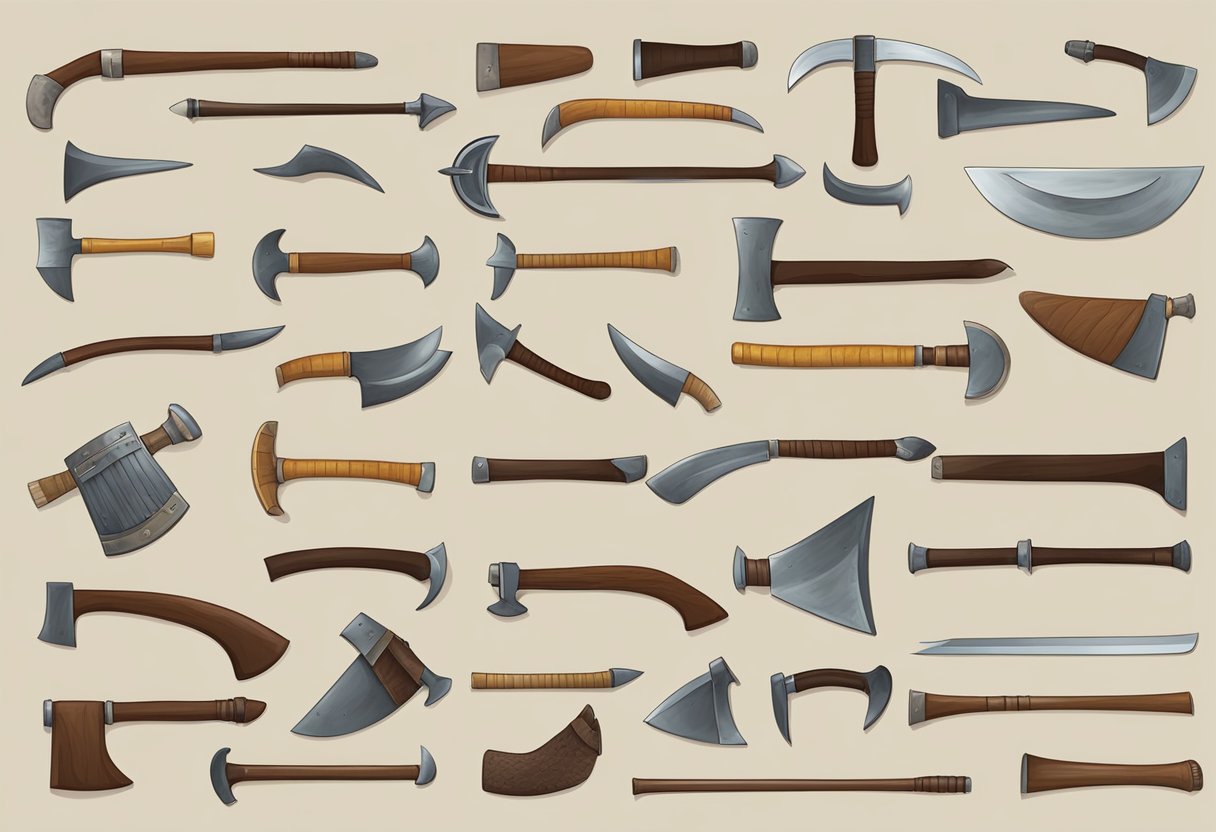Types Of Axes
Axes have been used for centuries for various purposes, including hunting, woodworking, and warfare. The axe is a versatile tool that can be used for felling trees, splitting wood, and shaping timber. The design of the axe has evolved over time, with different types of axes being developed for specific tasks.
The historical significance of axes cannot be overstated. Axes have been used for thousands of years, with the earliest known axe dating back to 6000 BC. The axe played a critical role in the development of human civilization, allowing people to clear land, build homes, and create tools and weapons. Today, axes are still widely used, although they are more commonly used for recreational activities such as camping and hiking.
Key Takeaways
- Axes have been used for centuries for various purposes, including hunting, woodworking, and warfare.
- The design of the axe has evolved over time, with different types of axes being developed for specific tasks.
- The historical significance of axes cannot be overstated.
Historical Significance of Axes

Axes have been used for thousands of years as both tools and weapons. The evolution of axe design has been shaped by the materials available and the needs of those who used them. This section will explore the historical significance of axes, including their evolution and their use as tools and weapons.
Evolution of Axe Design
The earliest axes were made of stone and were used for a variety of tasks, including hunting, butchering, woodworking, and building. Over time, as humans discovered new materials, axe design evolved. Copper and iron were used to create stronger, more durable axes that could be used for heavier tasks.
One notable type of axe is the battle axe, which was used primarily as a weapon during medieval times. The Viking axe, in particular, was a type of battle axe that was known for its sharp blade and sturdy design. It was used by Viking warriors for both hand-to-hand combat and throwing.
Axes as Tools and Weapons
Axes have been used throughout history as both tools and weapons. They were used by early humans for a variety of tasks, including chopping wood, building shelter, and hunting. As metalworking techniques improved, axes became more durable and versatile, and were used for heavier tasks such as felling trees and shaping timber.
In addition to their use as tools, axes were also used as weapons. The battle axe was a popular weapon during medieval times, and was used by knights and soldiers alike. Its long handle and sharp blade made it a formidable weapon in hand-to-hand combat.
Overall, the historical significance of axes lies in their versatility and durability. From the earliest stone axes to the modern steel axes used today, they have been an essential tool and weapon for humans throughout history.
Anatomy of an Axe
Parts of an Axe
An axe consists of two main parts: the handle and the axe head. The axe head is the hard section of the tool which does the cutting. It has a bit, toe, heel, beard, cheek, and butt. The bit is the sharp edge of the axe head that is used for cutting. The toe is the top of the bit, and the heel is the bottom. The beard is the curved section of the axe head that connects the toe to the heel. The cheek is the side of the axe head opposite the cutting edge, and the butt is the end of the axe head opposite the bit.
The axe handle, also known as the haft, is the long wooden section of the tool that is used to hold and swing the axe head. It comprises an eye, knob, throat, belly, and shoulder. The eye is the hole in the axe head where the handle is inserted. The knob is the rounded section at the bottom of the handle that prevents the axe from slipping out of the user’s hand. The throat is the section between the knob and the belly that provides a comfortable grip for the user’s hand. The belly is the thickest part of the handle, and it provides the most leverage for the user’s swing. The shoulder is the section of the handle that connects to the axe head.
Materials and Construction
The handle of an axe is typically made of wood, with ash and hickory being the most common woods used due to their strength and durability. The axe head is usually made of steel, which is strong and holds a sharp edge well. The axe head is attached to the handle by fitting the handle into the eye of the axe head and securing it with wedges or pins.
In conclusion, understanding the anatomy of an axe is essential for selecting the right tool for the job and using it safely and effectively. The handle and axe head are the two main parts of an axe, with the handle typically made of wood and the axe head made of steel. Knowing the different parts of an axe and their functions can help users make informed decisions when purchasing and using this versatile tool.
Types of Axes and Their Uses
When it comes to axes, there are various types available in the market, each with its own unique features and uses. In this section, we will explore the different types of axes and their uses.
Felling Axes
Felling axes are designed for chopping down trees. They have a long, straight handle that allows for a powerful swing and a large, heavy head that can easily cut through thick branches. Felling axes are typically used by professional lumberjacks and are not recommended for beginners.
Splitting Axes
Splitting axes are designed for splitting logs into smaller pieces. They have a wedge-shaped head that is wider than that of a felling axe, making it easier to split wood. Splitting axes are typically shorter than felling axes, which allows for more control when striking the log.
Hatchets and Tomahawks
Hatchets and tomahawks are smaller axes that are designed for camping, survival, and gardening. They have a shorter handle and a smaller head, making them easier to carry and use in tight spaces. Hatchets are typically used for chopping small branches and splitting kindling, while tomahawks are used for hunting and self-defense.
Specialized Axes
There are also specialized axes available for specific tasks. For example, a carpenter’s axe is designed for woodworking and has a thin, curved blade that allows for precise cuts. A forest axe is designed for outdoor use and has a longer handle for increased leverage. A double bit axe has two blades, one on each side of the head, which allows for more efficient chopping.
In addition, there are also axes designed for specific activities such as camping and survival. These axes are typically lightweight and compact, making them easy to carry in a backpack. They are designed for tasks such as chopping firewood, building shelter, and clearing brush.
Overall, when choosing an axe, it is important to consider the task at hand and select the appropriate type of axe for the job. With the right axe, you can make quick work of any chopping or splitting task.
Selecting the Right Axe
When selecting the right axe, there are several factors to consider. These include the task at hand, weight and handle length, and axe maintenance.
Considerations Based on Task
The type of axe needed will depend on the task at hand. For example, a felling axe is designed to cut through the fibers of a tree, while a splitting axe is designed to split logs. A hatchet, on the other hand, is smaller and more versatile, making it ideal for camping trips and other outdoor activities.
Weight and Handle Length
The weight and handle length of an axe are also important considerations. A heavier axe can provide more power, but may be more difficult to control. A longer handle can provide more leverage, but may also be more difficult to handle. It is important to find the right balance between weight and handle length to ensure that the axe can be used effectively and safely.
Axe Maintenance
Proper maintenance is essential to keep an axe in good condition. This includes keeping the blade sharp, oiling the wooden handle to prevent cracking, and checking the wedge periodically to ensure that it is secure. Fiberglass handles require less maintenance than wooden handles, but may not provide the same level of grip.
Overall, selecting the right axe requires careful consideration of the task at hand, weight and handle length, and maintenance requirements. By taking these factors into account, one can choose an axe that is both effective and safe to use.
Cultural and Modern Symbolism
Axes have been used for various purposes throughout history, including as weapons, tools, and ceremonial objects. As such, they hold diverse symbolic meanings in different cultures and contexts. The following subsections explore the cultural and modern symbolism of axes.
Axes in Mythology and Folklore
Axes have played a significant role in mythology and folklore across cultures. In Norse mythology, the god Thor is often depicted wielding a hammer or axe, which symbolizes his strength and power. The double-headed axe, known as the labrys, was a symbol of power and authority in Minoan culture. In Greek mythology, the god Hephaestus was known for his skill in crafting weapons and tools, including axes.
In Native American culture, the tomahawk was a symbol of both war and peace. It was used as a weapon in times of conflict, but also as a ceremonial object in peace negotiations. Similarly, in African cultures, the axe was used as a symbol of power and authority, and was often carried by chiefs and other important figures.
Contemporary Uses and Symbolism
In modern times, axes continue to hold symbolic meaning in various contexts. The fire axe, for example, is a symbol of bravery and heroism in firefighting. The tactical axe is a tool used by law enforcement and military personnel, and is often associated with strength and power. The ice axe is a tool used for mountaineering and represents the courage and determination required to climb mountains.
Survival axes, on the other hand, are tools used for outdoor activities such as camping and hiking. They represent self-sufficiency and the ability to survive in the wilderness. Throwing axes have become popular in recent years as a recreational activity, and are often associated with strength and precision.
In conclusion, axes have played a significant role in human history and continue to hold symbolic meaning in various contexts. Whether used as weapons, tools, or ceremonial objects, they represent strength, power, and determination.






